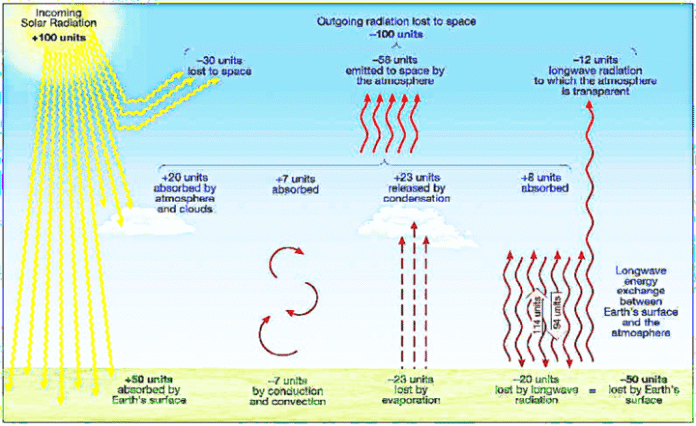By Jim Steele
Focusing only on CO2’s warming effect distorts our understanding of how the atmosphere warms and cools. More importantly it ignores how CO2 is critical for cooling our atmosphere. Oxygen and nitrogen comprise 99% of our atmosphere. Those molecules do not absorb or emit radiation. Our air is heated by collisions with solar heated surfaces and warmer atmospheric molecules. So, we must understand how oxygen and nitrogen shed their absorbed energy, so it can exit back to space.
Only the sun’s radiation adds heat to our world. Of the arriving solar heat 30% is reflected without warming the earth. 20% warms the atmosphere directly and only 50% warms the earth’s surface.
About 25% of that surface heat (12 units) gets radiated back to space immediately at wavelengths that are not affected by greenhouse gases.
About 14% (7 units) of the surface heat warms the air above via surface collisions with that heated air carried away from the surface by rising convection.
Slightly less than 50% (23 units) of the surface heat causes evaporation with moist convection also carrying heat away from the surface.
The surface only radiates 16% (8 units) of absorbed heat away, which is however also intercepted by greenhouse gases, primarily water and CO2. But greenhouse gases redirect some of that heat back to the surface and slow the earth’s cooling rate.
Eventually at the top of our atmosphere (the troposphere) greenhouse gases must radiate about 58% of all incoming solar heat back to space.
This diagram illustrates the physics showing how the earth cools by radiating infrared heat back to space according to Planck’s Law.

The 320k dashed line represents how much heat via each infrared wavelength should theoretically radiate back to space if there is no interference from greenhouse gases. Here, its from the Sahara desert’s surface when the surface is heated to 47 Celsius. This theoretical line is based on solid reproducible & trustworthy science.
The other dashed lines represent how much heat each wavelength should radiate from cooler temperatures. These cooler temperatures happen at higher altitudes as seen in the table on the right.
The solid black line represents what wavelengths of heat that satellites actually detected leaving earth. The thin red lines are model predictions. Only infrared heat with wavelengths between 10 and 13 microns as well as between 8 and 9.5 match theory. That’s because greenhouse gases do not interfere with those wavelengths, allowing 25% of the surface heat to escape immediately.
Water vapor absorbs infrared wavelengths between 14 & 25 microns as well and between 6 & 8 microns. Satellites detect those wavelengths but with intensities suggesting the heat has radiated from cooler temperatures. Satellites can’t detect the latent heat absorbed during water’s evaporation at the surface, but satellites do see the heat once released when water vapor cools and condenses to form clouds and rain at 1 to 4 kilometers of altitude. Above water vapor’s condensation altitudes, water vapor provides an insignificant greenhouse effect as the air is very dry.
CO2 primarily absorbs infrared centered around 15 micron wavelengths but satellites do not detect any heat from 15 micron wavelengths being emitted from the surface or lower atmosphere. So, a second critical question is why don’t satellites detect 15 micron wavelengths until the top of the troposphere and stratosphere? Radiant heat proven to be absorbed and emitted by CO2.
Greenhouse theory argues infrared absorbed by CO2 is trapped near the surface according to the following model.

Surface heat radiates upward but some is intercepted by greenhouse gases.
Those gases absorb the infrared heat but then quickly emit it. However, about half is redirected back towards the surface, slowing the surface’s cooling rate.
The infrared that continues upwards is again intercepted sending half back towards the surface
The same dynamic continues so by 2 to 4 kilometers altitude, virtually no surface radiation absorbed and emitted by CO2 escapes. So, satellites simply don’t detect it.
The same diminishing dynamic reduces the amount of infrared emitted from higher altitudes that can reach the surface. So, most scientists believe warming via a greenhouse effect happens mostly in the lowest atmosphere.
But this dynamic only partially explains atmospheric warming.

That greenhouse theory does not account for how collisions, as illustrated by Newton’s Cradle, that transfer energy from greenhouse gases to non-greenhouse gases and vice versa.
Water and CO2 do not trap absorbed infrared heat, but quickly emit it in just milliseconds after it is absorbed. This is called the relaxation time.

Now compare well studied collision frequencies to relaxation times.
Near the surface, nitrogen molecules can collide with CO2 6 billion times in just one second. So, before a CO2 molecule can relax and emit any radiation, nitrogen will collide 600,000 times with CO2 and steal it’s absorbed energy and transfer it to other atmospheric molecules via more collisions.
Collisions with nitrogen and oxygen constantly steal heat from CO2 and because nitrogen and oxygen don’t radiate that heat, satellites don’t detect any wavelengths centered around 15 microns until CO2 emits that heat in the stratosphere.
Heat trapped by oxygen and nitrogen can only lose that collisionally absorbed heat by transferring energy back to a greenhouse gas via more collisions. Only then can greenhouse gases radiate that energy back to space. However, CO2 will only radiate heat back to space where heat stealing collisions are greatly reduced, and that only happens in the less dense upper troposphere and stratosphere, exactly where satellites detect 15 micron wavelength emissions back to space.
Heated air constantly convects to the upper atmosphere, but without CO2, there would be no shedding of the air’s absorbed energy. There would only be runaway warming.
Greenhouse warming in the lower atmosphere is balanced by CO2 cooling in the stratosphere. This explains why CO2 concentrations do not correlate with earth’s temperatures over millions of years!
Related
Discover more from Watts Up With That?
Subscribe to get the latest posts sent to your email.
